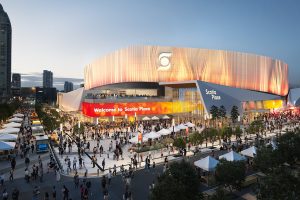Warren Knowles, the managing principal for RDH Building Engineering Ltd., explained the opportunities available to retrofit existing buildings to improve energy efficiency at Sustainabuild Vancouver on June 25.
Warren Knowles, the managing principal for RDH Building Engineering Ltd., explained the opportunities available to retrofit existing buildings to improve energy efficiency at Sustainabuild Vancouver on June 25.
Knowles said multi-family buildings are big greenhouse gas (GHG) emitters, but most people who live in those buildings have no idea what the energy costs are.
Generally, glass buildings such as the ones predominant in Vancouver don’t do very well in terms of energy efficiency. A large amount of energy is used by space heating, Knowles said, but lighting can be a factor, as can hot water.
There is clearly a need to improve, Knowles said, and pointed to Seattle’s practice of benchmarking buildings as a good place to start and a “hugely valuable” source of information. New York City has also conducted much valuable research, he said.
The Vancouver building retrofit strategy and the Greenest City Action Plan do good work to reduce GHGs and have also conducted analysis on multi-family unit energy use.
Energy consumption of a typical high-rise building fluctuates throughout the year, not surprisingly going down in summer and up in winter.
Space heating is a key factor in reducing energy consumption in buildings, Knowles said. Surprisingly, many buildings built today are not as well-insulated as older wood frame houses.
“Glazing is the weakest link, by far,” Knowles said. He added that for window walls, spandrels are poor thermal performers, and the effective R-value of spandrel panel assemblies are only slightly better than the windows themselves.
On average with the buildings studied by Knowles, the majority used gas for space heating and the reason for that is air flow.
“Where is that air going?” Knowles asked. He pointed out that people actually live in buildings and sometimes open windows, and that can have a tremendous effect on air flow. Controlling air flow can have a big effect on energy efficiency, he added.
With ventilation, corridor pressurization does not provide intended ventilation rates, he said.
Knowles said he and his colleagues applied these findings to a pilot project, and the approach they took was passive design.
The Belmont, a 13-storey multifamily residential building in Vancouver with 37 two-bedroom units built in the 1980s was selected as a test-bed.
The building needed minor repairs, needed aging components renewed and the owners wanted to improve durability to reduce future maintenance costs.
Retrofitting started with a condition assessment, and progressed to building renewal with energy efficient measures.
The building enclosure upgrades were done in 2012, with a year of measurement and analysis. Mechanical upgrades will happen this year.
The building has exposed concrete walls, and some window interface leaks. The original mechanical systems were still in place, with electric baseboard heating and some gas fireplaces in upper suites.
The building has exposed concrete walls, and some window interface leaks. The original mechanical systems were still in place, with electric baseboard heating and some gas fireplaces in upper suites.
Over clad and insulate walls were used, and new roofs and decks were installed. Air tightness was improved.
It was a seven month construction period, with work primarily from the exterior, with access to suites for window insulation.
A key part of the project was confirming energy measurements to see if the work had had an effect on consumption.
The next key procces will be improving the ventilation, he said.
Over all and space heating savings were consistent with predicted savings, and the Belmont was honoured with four different awards for energy efficiency, he said.
JOC DIGITAL MEDIA










Recent Comments
comments for this post are closed